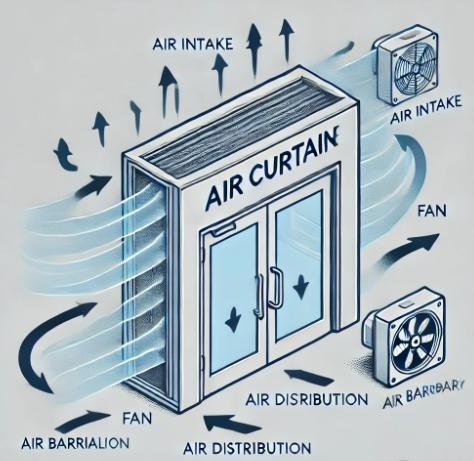1. 산업용 에어 커튼이란?
산업 에어 커튼의 설명
산업용 에어 커튼이 산업 시설 입구 위 또는 그에 따라 설치됩니다., 창고와 같은, 공장, 냉장 저장 장치. 주요 기능은 다른 환경을 분리하는 보이지 않는 공기 장벽을 만드는 것입니다., 외부와 내부 공간 사이의 공기 교환을 효과적으로 방지.
산업용 에어 커튼 역사
에어 커튼의 개념은 20 세기 초부터 주변에있었습니다., 다양한 산업의 증가하는 요구를 충족시키기 위해 수십 년 동안 크게 발전. 산업 공기 커튼의 역사는 효율성 향상을 목표로하는 지속적인 혁신의 여정을 반영합니다., 안전, 산업 환경에서의 환경 통제
산업용 에어 커튼의 기능

온도 제어: 실내와 실외 환경 간의 분리를 유지함으로써, 산업용 에어 커튼은 원하는 내부 온도를 보존하는 데 도움이됩니다.. 이것은 엄격한 온도 조절이 필요한 시설에 특히 중요합니다., 냉장 저장 장치와 같은.
에너지 효율: 에어 커튼은 가열 또는 냉각 공기의 손실을 최소화합니다., 따라서 기후 제어에 필요한 에너지를 줄입니다. 이것은 상당한 에너지 절약과 운영 비용 절감으로 이어집니다..
오염 물질 예방: 이 장치는 먼지를 방지합니다, 연기, 곤충, 시설에 들어가는 다른 오염 물질, 깨끗하고 안전한 작업 환경을 보장합니다.
향상된 안락함: 초안을 줄이고 안정적인 내부 온도를 유지함으로써, 에어 커튼은 근로자와 방문객 모두의 편안함 수준을 향상시킵니다..
안전성 증가: 교통량이 많은 산업 환경에서, 에어 커튼은 물리적 장벽의 필요성을 줄임으로써 가시성을 향상시킬 수 있습니다., 따라서 안전을 향상시킵니다.
작업 원칙

산업용 에어 커튼은 다른 환경들 사이에서 보이지 않는 장벽으로 작용하는 고속 기어 스트림을 만드는 원리에 따라 작동합니다.. 이 공기 장벽은 공기 교환을 방지하여 산업 시설 내에서 원하는 조건을 유지하는 데 도움이됩니다., 오염 물질, 그리고 온도. 다음은 작업 원리에 대한 자세한 설명입니다:
2. 산업 에어 커튼의 적용
물류 및 창고

출입구 단열재: 대형 창고 및 물류 센터에서, 에어 커튼은 뜨겁고 차가운 공기의 교환을 효과적으로 방지합니다., 안정적인 내부 온도 유지, 특히 자주 열린 문에서.
먼지와 곤충 예방: 에어 커튼도 먼지를 방지합니다, 곤충, 창고에 들어가는 다른 오염 물질, 저장된 상품의 청결과 안전을 보장합니다.
냉장 보관 및 냉장 시설

온도 제어: 냉장 보관 및 냉장 시설은 부패하기 쉬운 음식 및 기타 온도에 민감한 품목을 저장합니다.. 에어 커튼은 저온 환경을 유지하고 에너지 소비를 줄이는 데 도움이됩니다..
서리 감소: 따뜻함을 방지함으로써, 촉촉한 공기가 들어가는 것, 에어 커튼은 냉장장 내부의 서리 발생을 줄입니다., 따라서 해동 빈도와 비용을 낮추는 것입니다.
제조 플랜트

워크숍 격리: 공장에서, 다른 워크샵마다 온도가 다양 할 수 있습니다, 습기, 또는 청결 요구 사항. 에어 커튼은 이러한 워크샵을 효과적으로 분리합니다, 각각의 환경 조건을 유지합니다.
오염 제어: 에어 커튼은 유해한 가스를 방지합니다, 연기, 또는 다른 오염 물질은 다른 지역으로 퍼지는 것입니다, 직원 건강 및 생산 환경 보호.
식품 가공 공장
위생 제어: 식품 가공 공장에서, 에어 커튼은 곤충 및 기타 오염 물질을 가공 지역에 들어가는 것을 막습니다., 위생적이고 안전한 식품 가공 환경 보장.
온도 관리: 처리 영역에서 안정적인 온도를 유지하는 데 도움이됩니다, 외부 온도 변동이 식품의 질에 영향을 미치는 방지.
전자 및 정밀 제조
깨끗한 방: 전자 제품 및 정밀 제조에는 먼지 및 온도를 엄격하게 제어해야합니다.. 클리닝 룸 입구의 에어 커튼은 효과적인 공기 장벽을 제공합니다., 실내 청결 유지.
정적 예방: 일부 에어 커튼은 정적 축적을 줄이도록 설계되었습니다, 섬세한 전자 구성 요소 보호.
화학 및 제약 산업
안전 보호: 위험한 화학 물질을 처리하는 지역에서, 에어 커튼은 유해한 가스가 퍼지는 것을 방지합니다, 다른 지역과 직원을 보호합니다.
환경 고립: 그들은 다른 프로세스 영역을 분리합니다, 교차 오염 방지 및 생산 품질 향상.
워크숍 입구

차량 진입: 워크샵 입구에서, 특히 차량 트래픽이 많은 곳, 에어 커튼은 외부 먼지와 오염 물질이 차량에 의해 실내에서 가져 오는 것을 방지합니다., 워크샵을 깨끗하게 유지합니다.
3. 산업용 에어 커튼의 유형
공기 흐름 방향 또는 설치 방법으로
수평 산업 공기 커튼은 가장 일반적인 유형이며 일반적으로 출입구 또는 개구부 위에 설치됩니다.. 그들은 개구부를 가로 질러 아래쪽으로 날아가는 수평 공기 흐름을 만듭니다., 보이지 않는 장벽을 형성합니다
수직 산업 에어 커튼은 출입구 또는 개구부 측에 설치됩니다., 그리고 입구를 가로 질러 수평으로 불어 오는 수직 공기 흐름을 만듭니다.. 그것들은 덜 일반적이지만 수평 에어 커튼이 실용적이지 않을 수있는 특정 응용 분야에서 유용합니다.
기능 별
표준 에어 커튼: 실내 및 실외 환경을 분리하는 공기 장벽을 만들도록 설계되었습니다.. 이 유형의 가열 기능이없는 에어 커튼,냉장에서 사용하는 데 적합하지 않습니다.
가열 된 에어 커튼: 입구를 가로 질러 날기 전에 공기를 따뜻하게하는 가열 요소가 장착되어 있습니다.. 이들은 추운 기후 또는 겨울 동안 특히 유용합니다., 그들은 차가운 공기가 들어가는 것을 방지하면서 추가 난방을 제공함으로써 따뜻한 내부 환경을 유지하는 데 도움이됩니다..
냉장 에어 커튼: 차가운 에어 커튼이라고도합니다, 냉장 시설에서 사용됩니다, 슈퍼마켓, 저온을 유지하는 것이 매우 중요합니다.. 따뜻한 공기가 들어가는 것을 방지하기 위해 차가운 공기를 아래로 날려 버립니다., 따라서 멋진 환경을 보존합니다.
4. 선택 산업용 에어 커튼
문 크기를 기준으로
너비와 높이: 출입구의 너비와 높이를 측정하거나 에어 커튼이 설치 될 곳의 개구부를 측정합니다.. 에어 커튼은 전체 너비를 덮고 바닥에 도달하기에 충분한 공기 흐름을 생성 할 수있을 정도로 넓어야합니다..
다중 유닛: 넓은 오프닝, 나란히 배치 된 여러 에어 커튼 장치 사용 고려.
설치 높이를 기준으로
장착 높이: 에어 커튼이 장착 될 높이를 결정하십시오.. 에어 커튼에는 장착 높이에 따라 성능 기능이 다릅니다.
사용 환경을 기반으로합니다
환경 적 요인: 습도와 같은 요소를 고려하십시오, 먼지, 환경에서의 화학적 노출,그런 다음 스테인레스 스틸 산업 에어 커튼을 사용할 수 있습니다..
공기 흐름 속도와 볼륨을 기반으로합니다
공기 속도: 강한 장벽을 만들기 위해 적절한 공기 흐름 속도가있는 에어 커튼을 선택하십시오.. 상당한 압력 차이가있는 지역이나 강한 초안이있는 지역에는 더 높은 속도가 필요합니다..

풍량: 장치가 충분한 양의 공기를 이동하여 출입구를 효과적으로 덮을 수 있는지 확인하십시오.
온도 제어:
표준 대. 가열 vs. 냉장: 표준을 선택하십시오, 가열, 또는 온도 제어 요구에 따른 냉장 에어 커튼.

에너지 효율 및 소음 제어를 기반으로합니다
운영 비용: 에어 커튼의 에너지 소비와 운영 비용에 미치는 영향을 고려하십시오.. 에너지 효율적인 모델은 장기 절약을 제공 할 수 있습니다. 에어 커튼의 도어 스위치 또는 도어 센서를 선택하여 에너지를 절약 할 수 있습니다..
여전히 산업용 에어 커튼을 선택하는 방법을 모르는 경우, 우리 팀에 연락 할 수 있습니다, 우리는 하루 안에 솔루션을 제공 할 것입니다.
브랜드 및 품질 비교
보증 및 지원: 제조업체가 좋은 보증과 안정적인 고객 지원을 제공하는지 확인하십시오.. Cdairtech는 설치 후 2 년 보증을 제공합니다. 그리고 항상 7*24 시간에 대한 온라인 지원.
5. 산업 에어 커튼의 설치 및 유지 보수
설치 단계
매뉴얼을 읽으십시오: 제조업체의 설치 설명서 및 지침을주의 깊게 읽으십시오.
구성 요소를 확인하십시오: 모든 구성 요소와 액세서리가 존재하고 상태가 양호한 지 확인하십시오..
도구 및 장비: 필요한 모든 도구와 장비를 수집하십시오, 드릴과 같은, 드라이버, 테이프 측정, 수준, 및 장착 브래킷.
개구부를 측정하십시오: 에어 커튼이 올바른 크기인지 확인하기 위해 출입구의 너비와 높이 또는 개구부를 측정합니다..
장착 위치를 결정합니다: 에어 커튼이 문 위에 수평으로 장착 될지 또는 측면에서 수직으로 장착할지 여부를 결정합니다., 특정 응용 프로그램을 기반으로합니다.
장착 지점을 표시하십시오: 레벨을 사용하여 벽이나 도어 프레임에 장착 지점을 표시합니다.. 마크가 레벨이고 균등하게 간격을두고 있는지 확인하십시오.
드릴 구멍: 장착 브래킷의 표시된 지점에 구멍을 뚫습니다.. 벽 재료를 기준으로 적절한 드릴 비트를 사용하십시오.
브래킷을 설치하십시오: 적절한 나사와 앵커를 사용하여 장착 브래킷을 벽이나 프레임에 고정하십시오.
에어 커튼을 들어 올리십시오: 조수의 도움으로, 에어 커튼 장치를 들어 올려 마운팅 브래킷과 정렬하십시오..
장치를 고정하십시오: 에어 커튼을 장착 브래킷에 부착하고 제조업체에서 지정된대로 볼트 또는 나사를 사용하여 고정하십시오..
정렬을 확인하십시오: 에어 커튼이 올바르게 정렬되고 공기 흐름을 골고루 분배 할 수 있도록 레벨이 있는지 확인하십시오..
전원 공급 장치: 전기 연결을하기 전에 전원 공급 장치가 꺼져 있는지 확인하십시오..
배선: 제조업체의 배선 다이어그램에 따라 에어 커튼을 전원 전원에 연결하십시오.. 여기에는 전선을 전원 콘센트에 연결하거나 건물의 전기 시스템에 장치를 하드 배선하는 것이 포함될 수 있습니다..
안전 준수: 모든 전기 연결이 로컬 전기 코드 및 표준을 준수하는지 확인하십시오..
전원을 켜십시오: 전원 공급 장치를 켜고 에어 커튼을 테스트하여 올바르게 작동하는지 확인하십시오..
공기 흐름 조정: 효과적인 공기 장벽을 만들기 위해 필요에 따라 공기 흐름 방향 및 속도 설정 조정.
작업을 확인하십시오: 문이 열리고 닫히면 에어 커튼이 제대로 활성화되고 비활성화되는지 확인하십시오.
매일 유지 관리 및 관리
정기적 인 청소: 에어 필터를 청소하십시오, 섭취 그릴, 주기적으로 노즐을 배출합니다.
일상적인 검사: 모든 구성 요소의 일상적인 검사를 수행합니다, 팬 블레이드를 포함하여, 모터, 하드웨어 장착.
적시 수리: 추가 손상을 방지하기 위해 식별 된 모든 문제를 즉시 해결하십시오.
전문적인 서비스: 최적의 성능을 보장하기 위해 제조업체가 권장하는 전문 서비스 일정.
일반적인 문제 및 문제 해결
공기 흐름이 충분하지 않습니다
증상:
- 약한 공기 장벽
- 공기는 바닥에 도달하지 않습니다
- 일관되지 않은 공기 적용 범위
가능한 원인과 솔루션:
- 막힌 필터 또는 섭취 그릴: 적절한 공기 흐름을 보장하기 위해 에어 필터 및 흡기 그릴을 확인하고 청소하십시오..
- 차단 노즐: 공기 배출 노즐의 장애물 검사 및 청소.
- 팬 속도 설정: 팬 속도가 응용 프로그램에 적합한 수준으로 설정되었는지 확인하십시오..
- 착용 된 팬 블레이드: 팬 블레이드가 마모를 확인하고 필요한 경우 교체하십시오..
과도한 소음
증상:
- 시끄러운 작동
- 비정상적인 진동 또는 소리
가능한 원인과 솔루션:
- 느슨한 장착 하드웨어: 모든 장착 볼트와 나사를 검사하고 조입니다.
- 마모 된 베어링 또는 모터 문제: 마모 된 베어링 또는 모터 문제를 확인하고 필요한 경우 교체하십시오..
- 불균형 팬 블레이드: 팬 블레이드의 균형을 검사하고 필요에 따라 조정하거나 교체하십시오..
- 진동 분리: 유닛에 소음을 줄이기 위해 적절한 진동 분리가 있는지 확인.
에어 커튼이 켜지지 않습니다
증상:
- 힘이 없습니다
- 컨트롤에 응답하지 않는 장치
가능한 원인과 솔루션:
- 전원 공급 장치 문제: 전력 공급 장치를 점검하고 장치가 올바르게 연결되어 있고 전원을 수용하는지 확인하십시오..
- 퓨즈 또는 트립 회로 차단기를 날려 버렸습니다: 날아간 퓨즈를 검사하고 교체하거나 회로 차단기를 재설정하십시오..
- 결함이있는 스위치 또는 제어판: 스위치 또는 제어판에서 기능이 있는지 확인하고 필요한 경우 교체하십시오..
- 배선 문제: 느슨하거나 손상된 와이어에 대한 배선 연결을 검사하고 수리하십시오..
효율성 감소
증상:
- 에너지 소비 증가
- 성능 감소
가능한 원인과 솔루션:
- 더러운 필터 또는 구성 요소: 효율적인 작동을 보장하기 위해 필터 및 구성 요소를 정기적으로 청소하고 유지 관리합니다..
- 잘못된 설정: 장치의 설정이 특정 응용 프로그램에 최적화되었는지 확인하십시오..
- 마모 또는 손상된 부품: 마모되거나 손상된 부품을 교체하여 효율성을 복원하십시오.
6. 시장 산업 에어 커튼
산업 에어 커튼 시장은 에너지 효율에 대한 강조로 인해 상당한 성장을 겪고 있습니다., 상업 건설 활동 상승, 실내 기후 제어를 유지하고 에너지 비용을 줄이는 데있어 에어 커튼의 이점에 대한 인식 증가.
시장 규모와 성장:
- 글로벌 에어 커튼 시장은 대략 USD로 평가되었습니다. 1.37 10 억입니다 2023 USD에 도달 할 것으로 예상됩니다 2.46 10 억으로 2029, CAGR에서 성장합니다 12.48% ~에서 2024 2029 년까지 (시장 데이터 예측) (인지 시장 연구).
- 구체적으로, 에어 커튼 시장의 산업 부문은 제조 시설에서 광범위한 사용으로 인해이 기간 동안 가장 빠른 성장을 목격 할 것으로 예상됩니다., 창고, 냉장 저장 장치.
주요 드라이버:
- 에너지 효율: 에어 커튼은 컨디셔닝 된 공간의 에너지 손실을 최소화하고 외부 공기의 유입을 방지하여 건물 운영 비용을 줄이는 데 도움이됩니다., 상당한 에너지 절약으로 이어집니다.
- 건설 활동 상승: 상업용 건물의 건설 증가, 쇼핑 센터, 병원, 및 제조 시설, 특히 아시아 태평양과 같은 개발 도상국에서, 에어 커튼에 대한 수요를 높이고 있습니다
- 환경 통제: 에어 커튼은 온도를 효과적으로 제어합니다, 습기, 먼지, 그리고 곤충, 식품 가공과 같은 다양한 산업 응용 분야에서 중요합니다., 의약품, 전자 제조.
지역 통찰력:
- 북아메리카: 이 지역은 상업 및 산업 부문의 높은 채택률과 주요 시장 플레이어의 존재로 인해 에어 커튼 시장을 지배합니다..
- 아시아 태평양: 예측 기간 동안 가장 높은 CAGR에서 성장할 것으로 예상됩니다., 중국과 인도와 같은 국가의 빠른 인프라 개발 및 도시화에 의해 주도.
- 유럽: 엄격한 에너지 효율 규제 및 상업용 건물에서의 에어 커튼 사용으로 인한 상당한 시장 점유율
시장 제한:
- 설치 및 디자인 품질: 열악한 설치 관행과 표준 디자인은 시장 성장을 방해 할 수 있습니다., 예상 성능과 에너지 절약을 제공하지 않을 수 있으므로.
- 비용 문제: 초기 설치 비용과 정기 유지 보수의 필요성은 일부 비즈니스의 장벽이 될 수 있습니다., 특히 중소 기업



